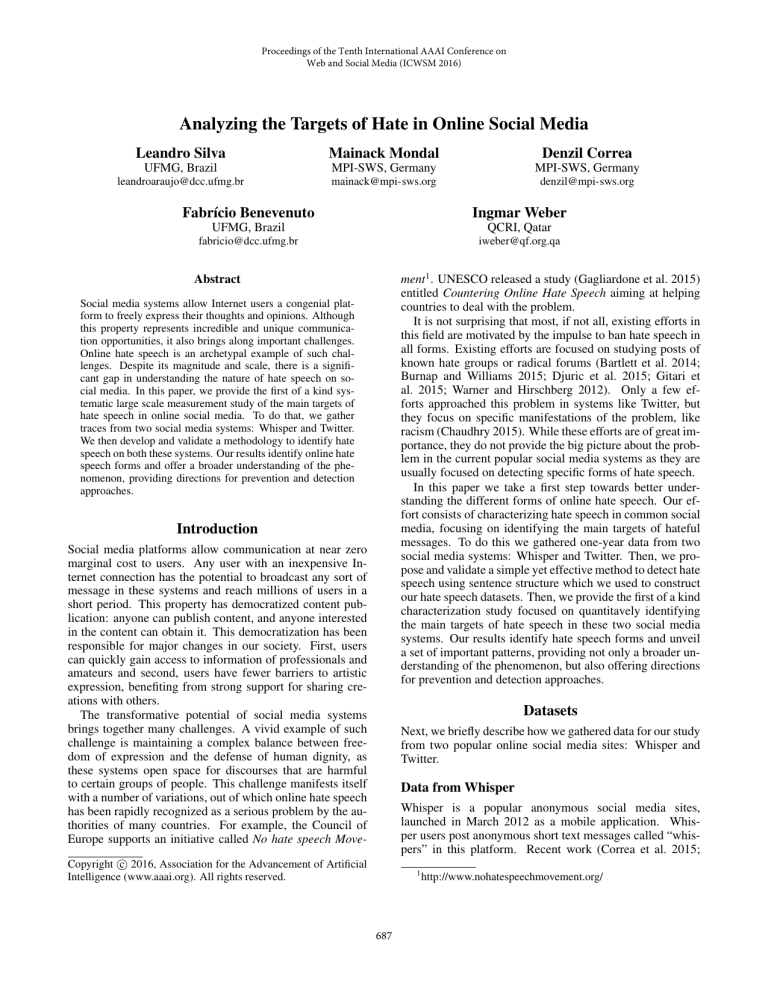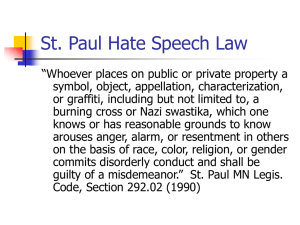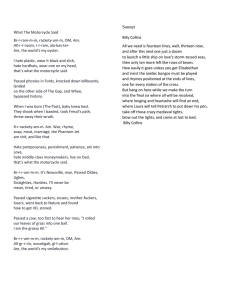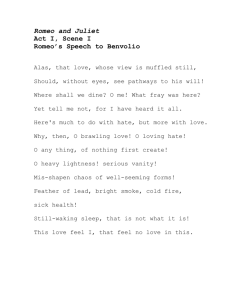
Proceedings of the Tenth International AAAI Conference on
Web and Social Media (ICWSM 2016)
Analyzing the Targets of Hate in Online Social Media
Leandro Silva
Mainack Mondal
Denzil Correa
UFMG, Brazil
MPI-SWS, Germany
MPI-SWS, Germany
leandroaraujo@dcc.ufmg.br
mainack@mpi-sws.org
denzil@mpi-sws.org
Fabrı́cio Benevenuto
Ingmar Weber
UFMG, Brazil
QCRI, Qatar
fabricio@dcc.ufmg.br
iweber@qf.org.qa
ment1 . UNESCO released a study (Gagliardone et al. 2015)
entitled Countering Online Hate Speech aiming at helping
countries to deal with the problem.
It is not surprising that most, if not all, existing efforts in
this field are motivated by the impulse to ban hate speech in
all forms. Existing efforts are focused on studying posts of
known hate groups or radical forums (Bartlett et al. 2014;
Burnap and Williams 2015; Djuric et al. 2015; Gitari et
al. 2015; Warner and Hirschberg 2012). Only a few efforts approached this problem in systems like Twitter, but
they focus on specific manifestations of the problem, like
racism (Chaudhry 2015). While these efforts are of great importance, they do not provide the big picture about the problem in the current popular social media systems as they are
usually focused on detecting specific forms of hate speech.
In this paper we take a first step towards better understanding the different forms of online hate speech. Our effort consists of characterizing hate speech in common social
media, focusing on identifying the main targets of hateful
messages. To do this we gathered one-year data from two
social media systems: Whisper and Twitter. Then, we propose and validate a simple yet effective method to detect hate
speech using sentence structure which we used to construct
our hate speech datasets. Then, we provide the first of a kind
characterization study focused on quantitavely identifying
the main targets of hate speech in these two social media
systems. Our results identify hate speech forms and unveil
a set of important patterns, providing not only a broader understanding of the phenomenon, but also offering directions
for prevention and detection approaches.
Abstract
Social media systems allow Internet users a congenial platform to freely express their thoughts and opinions. Although
this property represents incredible and unique communication opportunities, it also brings along important challenges.
Online hate speech is an archetypal example of such challenges. Despite its magnitude and scale, there is a significant gap in understanding the nature of hate speech on social media. In this paper, we provide the first of a kind systematic large scale measurement study of the main targets of
hate speech in online social media. To do that, we gather
traces from two social media systems: Whisper and Twitter.
We then develop and validate a methodology to identify hate
speech on both these systems. Our results identify online hate
speech forms and offer a broader understanding of the phenomenon, providing directions for prevention and detection
approaches.
Introduction
Social media platforms allow communication at near zero
marginal cost to users. Any user with an inexpensive Internet connection has the potential to broadcast any sort of
message in these systems and reach millions of users in a
short period. This property has democratized content publication: anyone can publish content, and anyone interested
in the content can obtain it. This democratization has been
responsible for major changes in our society. First, users
can quickly gain access to information of professionals and
amateurs and second, users have fewer barriers to artistic
expression, benefiting from strong support for sharing creations with others.
The transformative potential of social media systems
brings together many challenges. A vivid example of such
challenge is maintaining a complex balance between freedom of expression and the defense of human dignity, as
these systems open space for discourses that are harmful
to certain groups of people. This challenge manifests itself
with a number of variations, out of which online hate speech
has been rapidly recognized as a serious problem by the authorities of many countries. For example, the Council of
Europe supports an initiative called No hate speech Move-
Datasets
Next, we briefly describe how we gathered data for our study
from two popular online social media sites: Whisper and
Twitter.
Data from Whisper
Whisper is a popular anonymous social media sites,
launched in March 2012 as a mobile application. Whisper users post anonymous short text messages called “whispers” in this platform. Recent work (Correa et al. 2015;
c 2016, Association for the Advancement of Artificial
Copyright Intelligence (www.aaai.org). All rights reserved.
1
687
http://www.nohatespeechmovement.org/
Wang et al. 2014) suggests that users present a disinhibition complex in Whisper due to the anonymous setting. This
property combined with its large popularity, makes Whisper
an ideal environment for our study.
Whisper users can only post messages via mobile phones,
however Whisper has a read only-web interface. In order to
collect data from Whisper we employ a similar methodology as (Wang et al. 2014). We gather our dataset for one
year (from 6th June, 2014 to 6th June 2015) via the “Latest”
section of the Whisper website which contains a stream of
publicly posted latest whispers. Each downloaded whisper
contains the text of the whisper, location, timestamp, number of hearts (favorites), number of replies and username.
Overall, our dataset contains 48.97 million whispers
posted over the year. For simplyfying further analysis we
consider only the Whispers written in English and containing a valid location information. After this filtering step, we
end up with 27.55 million whispers. This corresponds to
our final Whisper dataset used in the next sections.
it is hard to infer individuals’ intentions and the extent to
which a message will harm an individual.
Using sentence structure to capture hate
Most existing efforts to measure hate speech require knowing the hate words or hate targets apriori (Kwok and Wang
2013). Differently, we propose a simple yet very effective
method for identifying hate speech in social media posts that
is in agreement with our definition of hate speech and that
allows us to answer our research questions. The key idea is
the following: If some user posts about their hateful emotions in a post, e.g., “I really hate black people”, then there
is little ambiguity that it is a hate post. In other words we
can leverage the sentence structure to detect hate speeches
with high precision very effectively. Clearly, this strategy
does not identify all the existing hate speech in social media,
which is fine given the purpose of the analysis presented in
this study. Based on this idea, we construct the following
basic expression to search in social media posts:
Data from Twitter
I < intensity >< userintent >< hatetarget >
Since we want to study hate speech in the online world,
along with Whisper we also collected and analyzed data
from Twitter, as it is one of the most popular social media sites today with more than 300 million monthly active
users. The main difference between Whisper and Twitter is
that users post in Twitter non-anonymously. In spite of the
non-anonymity, there is recent evidence of hate speech in
Twitter (Chaudhry 2015). Thus, we note than it is useful to
include Twitter in our study.
We collected the 1% random sample of all publicly available Twitter data using the Twitter streaming API for a period of 1 year – June 2014 to June 2015.
In total we collected 1.6 billion tweets (posts in Twitter)
during this period. Unlike Whisper, the default setting in
Twitter is not to add location to the posts. Consequently we
concentrate on only English tweets (both with and without
location) posted between June 2014 to June 2015. There
were 512 million tweets in our resulting tweet dataset.
The components of this expression are explained next.
The subject “I” means that the social media post matching
this expression is talking about the user’s personal emotions.
The verb, embodied by the <user intent> component specifies what the user’s intent is, or in other word how he feels.
Since we are interested in finding hate in social media posts,
we set the <user intent> component as “hate” or one of
the synonyms of hate collected from an online dictionary3 .
Some users might try to amplify their emotions expressed
in their intent but using qualifiers (e.g., adverbs), which is
captured by the <intensity> component. Note that users
might decide to not amplify their emotions and this component might be blank. Further the intensity might be negative which might disqualify the expression as a hate speech,
e.g., “I don’t hate X”. To tackle this, we manually inspect
the intent expressions found using our dataset and remove
the negative ones. Table 1 shows the top ten hate expressions formed due to the <intensity> component in conjunction with synonyms of hate. Although the simple expression
“I hate” accounts for the majority of the matches, we note
that the use of intensifiers was responsible for 29.5% of the
matches in Twitter and for 33.6% in Whisper. The final part
in our expression is related to the hate targets.
Determining hate targets: A simple strategy that searches
for the sentence structure I <intensity> <user intent>
<any word> results in a number of posts that do not contain
hate messages against people, i.e., “I really hate owing people favors”, which is not in agreement with our the definition
of online hate speech considered in our work. Thus, to focus
on finding hate against groups of people in our datasets, we
design two templates for the hate target component.
We design the first template for our <hate target> token
as simply “<one word> people”. For example we search
for patterns like “black people” or “mexican people”. This
template for <hate target> captures when hate is directed
Measuring Hate Speech
Before presenting our approach to measure online hate
speech, we provide a few definitions. Hate speech lies in
a complex nexus with freedom of expression, group rights,
as well as concepts of dignity, liberty, and equality (Gagliardone et al. 2015). For this reason, any objective definition
(i.e., that can be easily implemented in a computer program)
can be contested. We define hate speech as any offense motivated, in whole or in a part, by the offender’s bias against
an aspect of a group of people. Under this definition, online hate speech may not necessarily be a crime, but still
harm people. The offended aspects can encompass basic
hate crimes2 , such as race, religion, disability, sexual orientation, ethnicity, or gender, but may also include behavioral
and physical aspects that are not necessarily crimes. We do
not attempt to separate organized hate speech from a rant as
2
https://www.fbi.gov/about-us/investigate/civilrights/
hate crimes
3
688
http://www.thesaurus.com/browse/hate/verb
Twitter
I hate
I can’t stand
I don’t like
I really hate
I fucking hate
I’m sick of
I cannot stand
I fuckin hate
I just hate
I’m so sick of
% posts
70.5
7.7
7.2
4.9
1.8
0.8
0.7
0.6
0.6
0.6
Whisper
I hate
I don’t like
I can’t stand
I really hate
I fucking hate
I’m sick of
I’m so sick of
I just hate
I really don’t like
I secretly hate
% posts
66.4
9.1
7.4
3.1
3.0
1.4
1.0
0.9
0.8
0.7
“Black people”, “White people” or “Nigga” are the most
used hate targets. We further checked how many of these
hate messages are detected by our two different templates.
Overall, the template with “people” finds more hate speech
than using the words from Hatebase, accounting for 65% of
the Twitter dataset and 99% of the Whisper dataset. One
possible reason for this high difference in the two datasets
is that Whisper operators are already filtering out posts containing some of the words from Hatebase.
Evaluating our hate speech detection methodology
Next, we evaluate the precision of our hate speech detection approach. To that end we did a simple experiment:
We randomly sample 100 posts of all the whispers which
matched our language structure based expression. Then we
manually verify whether these 100 posts are really classified as hate speech by human judgment. We observe that
100% of both the whispers and tweets can be classified as
hate speech by human judgment, where the poster expressed
their hate against somebody. It is important to highlight that
our methodology was not designed to capture all or most of
the hate speech that in social media. In fact, detecting online
hate speech is still an open research problem. Our approach
aims at building a dataset that allow us to identify the main
targets of online hate speech.
Table 1: Top ten hate expressions in Twitter and Whisper.
towards a group of people. However we observe that even
with this template we found some false positives as there are
posts like “I hate following people”. To reduce the number
of such false positives we create a list of exclusion words
for this approach including words like following, all, any,
watching, when, etc.
Second, not all hate words come together with the term
“people”. To account for this general nature of hate speech
we employ the help of Hatebase 4 . It is the world’s largest
online repository of structured, multilingual, usage-based
hate speech. Hatebase uses crowdsourcing to build its collection of hate words. We crawled Hatebase on September
12, 2015 to collect a comprehensive list of hate words. There
are 1,078 hate words in Hatebase spanning eight categories:
archaic, class, disability, ethnicity, gender, nationality, religion, and sexual orientation. However each word in Hatebase comes with an offensivity score. The score varies from
0 to 100, with 100 indicating most offensive hate words.
Since our goal is to find serious hate speech from social media data we take only the hate words from Hatebase with
offensivity greater than 50%5 , and use those words as template for <hate target> tokens in our pattern.
Twitter
Hate target
Nigga
White people
Fake people
Black people
Stupid people
Rude people
Negative people
Ignorant people
Nigger
Ungrateful people
% posts
31.11
9.76
5.07
4.91
2.62
2.60
2.53
2.13
1.84
1.80
Categorizing Hate Speech
Our final methodological step consists of manually categorizing hate targets. For example, the term “black” should be
categorized as race and “gay” as sexual orientation. In order
to decide the hate categories we take inspiration from Hatebase. Hatebase along with the words gave us hate categories
like ethnicity, race, religion, etc. We also consider categories
reported by FBI for hate crimes. We combine these two sets
of categories and added two more for better coverage of our
data. We end up with nine categories: Race, Behavior, Physical, Sexual orientation, Class, Gender, Ethnicity, Disability,
and Religion. We also add an “other” category for any nonclassified hate targets. The final hate categories and some
examples of hate targets for each category are in Table 3.
Whisper
Hate target
% posts
Black people
10.10
Fake people
9.77
Fat people
8.46
Stupid people
7.84
Gay people
7.06
White people
5.62
Racist people
3.35
Ignorant people
3.10
Rude people
2.45
Old people
2.18
Categories
Race
Behavior
Physical
Sexual orientation
Class
Gender
Ethnicity
Disability
Religion
Other
Table 2: Top ten targets of hate in Twitter and Whisper.
Overall, our strategy was able to identify 20,305 tweets
and 7,604 whispers containing hate speech. We present
the top hated targets from Twitter and Whisper using our
methodology in Table 2. It shows that, racist hate words like
4
5
Example of hate targets
nigga, black people, white people
insecure people, sensitive people
obese people, beautiful people
gay people, straight people
ghetto people, rich people
pregnant people, cunt, sexist people
chinese people, indian people, paki
retard, bipolar people
religious people, jewish people
drunk people, shallow people
Table 3: Hate categories and example of hate targets.
Since manual classification of hate targets are resource
consuming, we aim to categorize only the top hate words
that cover most of the hate speech in our data. In total, the
Twitter and the Whisper datasets contain 264 and 242 unique
http://www.hatebase.org/
There are 116 such hate words in Hatebase
689
hate targets, respectively, and most of them appear in both
datasets. We manually label the most popular 178 targets,
which account for 97% of the Twitter data and also 97% of
the whispers. In the next section we look into these hate
categories and the associated hate speech from them more
in depth.
of how this very important problem of the modern society
currently manifests. Our effort even unveils new forms of
online hate that are not necessarily crimes, but can be harmful to people. We hope that our dataset and methodology can
help monitoring systems and detection algorithms to identify novel keywords related to hate speech as well as inspire
more elaborated mechanisms to identify online hate speech.
Building a hate speech detection system that leverages our
findings is also part of our future research agenda.
Targets of Online Hate Speech
We start with observing which categories of hate are most
prevalent in our experimental platforms – Twitter and Whisper. The results are shown in Table 4. The hate categories
are sorted by the number of hate speech in these categories
(except for the non-classified hate targets, which we put in
the other category). We made two interesting observations
from this table. First, for both Twitter and Whisper the top
three hate categories are the same – Race, behavior, and
physical. However, in Twitter these categories cover 89% of
the tweets, whereas in Whisper they cover only 69% of all
the whispers related to hate. One potential explanation for
this difference may be due some existing filtering that Whisper might already apply for very aggressive hate words, like
those from Hatebase. We also note that for these categories
in both Twitter and Whisper, there is also hate as a response
to hate, e.g., “I hate racist people”. However such types of
hate are not expressed in a high number of posts, and hate
with negative connotation is more common.
Secondly we observe that out of the top three hate categories for both Twitter and Whisper, the categories behavior and physical aspects are more about soft hate targets, like fat people or stupid people. This observation suggests that perhaps a lot of online hate speech
is targeted towards groups of people that are not generally included when documenting offline hate crimes.
For e.g., https://www.fbi.gov/news/stories/2015/november/
latest-hate-crime-statistics-available/ contains a breakdown
of offline hate crimes according to their bias.
Twitter
Categories
Race
Behavior
Physical
Sexual orientation
Class
Ethnicity
Gender
Disability
Religion
Other
% posts
48.73
37.05
3.38
1.86
1.08
0.57
0.56
0.19
0.07
6.50
Whisper
Categories
Behavior
Race
Physical
Sexual orientation
Class
Ethnicity
Religion
Gender
Disability
Other
Acknowledgments
This work was partially supported by the project FAPEMIGPRONEX-MASWeb, Models, Algorithms and Systems for
the Web, process number APQ-01400-14, and grants from
CNPq, CAPES, and Fapemig.
References
Bartlett, J.; Reffin, J.; Rumball, N.; and Williamson, S. 2014. Antisocial media. DEMOS.
Burnap, P., and Williams, M. L. 2015. Cyber hate speech on twitter: An application of machine classification and statistical modeling for policy and decision making. Policy&Internet 7(2):223–242.
Chaudhry, I. 2015. #hashtagging hate: Using twitter to track racism
online. First Monday 20(2).
Correa, D.; Silva, L.; Mondal, M.; Benevenuto, F.; and Gummadi,
K. P. 2015. The many shades of anonymity: Characterizing anonymous social media content. In Proc. of ICWSM.
Djuric, N.; Zhou, J.; Morris, R.; Grbovic, M.; Radosavljevic, V.;
and Bhamidipati, N. 2015. Hate speech detection with comment
embeddings. In WWW.
Gagliardone, I.; Gal, D.; Alves, T.; and Martinez, G. 2015. Countering online Hate Speech. UNESCO.
Gitari, N. D.; Zuping, Z.; Damien, H.; and Long, J. 2015. A
lexicon-based approach for hate speech detection. Int’l Journal of
Multimedia and Ubiquitous Engineering 10(4):215–230.
Kwok, I., and Wang, Y. 2013. Locate the hate: Detecting tweets
against blacks. In Proc. of AAAI.
Wang, G.; Wang, B.; Wang, T.; Nika, A.; Zheng, H.; and Zhao,
B. Y. 2014. Whispers in the dark: Analyzing an anonymous social
network. In Proc. of IMC.
Warner, W., and Hirschberg, J. 2012. Detecting hate speech on the
world wide web. In Proc. of LSM.
% posts
35.81
19.27
14.06
9.32
3.63
1.96
1.89
0.82
0.41
12.84
Table 4: Hate categories distribution.
Conclusion
The fight against perceived online hate speech is beginning
to reach a number of concerned parties, from governments
to private companies, as well as to a growing number of active organizations and affected individuals. Our measurement study about online hate speech provides an overview
690






